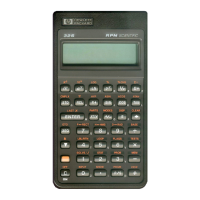The
Automatic
Memory
Stack
2
This chapter explains how calculations take place in the automatic
memory stack and why this method minimizes the number of key
strokes for complicated calculations.
You
do not
need
to
read
and
understand
this
material
to use the
calculator.
However, you will find
that understanding this material greatly enhances your use of the cal
culator, especially when programming.
In part 2, Trogramming*, you will see that the stack helps manipulate
and
organize data for programs.
What
the
Stack
Is
Automatic
storage
of
intermediate
results
is the reason
that
the HP-32S
easily processes the most complex calculations,
and
does so without
parentheses. The key to automatic storage is the
automatic,
RPN
mem
ory stack*
The memory stack consists of four storage locations, called
registers,
which are 'stacked' on top of each other. It is a work area for calcula
tions. These registers—labeled X,
Y,
Z, and T—store
and
manipulate
four
current
numbers.
The
'oldest'
number
is
the
one
in
the
T- (top)
register.
1HP's operating logic is based on an unambiguous, parentheses-free mathematical logic
known as "Polish Notation,' developed by the Polish logician Jan Lukasiewicz (1878—
1956).While conventional
algebraic
notation placesthe operators
between
the relevantnum
bers or variables, -Lukasiewicz's notation places them
before
the numbers or variables.
For
optimalefficiencyof the stack,we have modified that notationto specifythe
operators
after
the
numbers.
Hence
the
term
Reverse Polish Notation, or RPN.
2:
The
Automatic
Memory
Stack
35

